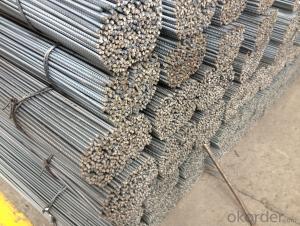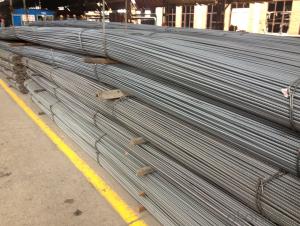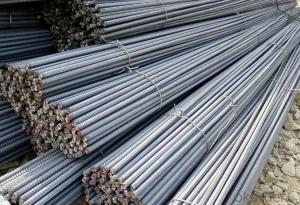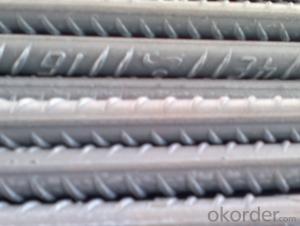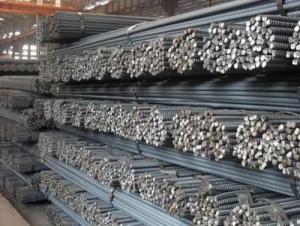Hot Rolled Deformed Steel Rebars for Constrution
- Loading Port:
- Tianjin
- Payment Terms:
- TT OR LC
- Min Order Qty:
- -
- Supply Capability:
- 200000 m.t./month
OKorder Service Pledge
OKorder Financial Service
You Might Also Like
Specifications of Hot Rolled Deformed Steel Rebars for Constrution:
Standard | GB UK USA | HRB335 HRB400 HRB500 G460B, B500A, B500B,B500C GR40, GR60 | |
Diameter | 6mm,8mm,10mm,12mm,14mm,16mm,18mm,20mm, 22mm,25mm,28mm,32mm,36mm,40mm,50mm | ||
Length | 6M, 9M,12M or as required | ||
Price | Keep lower operating costs so as to offer competitive price for our clients | ||
Delivery Detail | within 45 days after received advanced payment or LC. | ||
Application | mainly used in construction industry to reinforce concrete structures and so on | ||
Invoicing | Actual or Theoretical Weight Basis as buyer’s request. | ||
Type | Hot rolled steel rebar | ||
Brand name | DRAGON | ||
Theoretical weight and section area of each diameter as below for your information:
Diameter(mm) | Section area (mm²) | Mass(kg/m) | Weight of 12m (kg) | Pcs/ton |
6 | 28.27 | 0.222 | 2.664 | 375.38 |
8 | 50.27 | 0.395 | 4.74 | 210.97 |
10 | 78.54 | 0.617 | 7.404 | 135.06 |
12 | 113.1 | 0.888 | 10.656 | 93.84 |
14 | 153.9 | 1.21 | 14.52 | 68.87 |
16 | 201.1 | 1.58 | 18.96 | 52.74 |
18 | 254.5 | 2.00 | 24 | 41.67 |
20 | 314.2 | 2.47 | 29.64 | 33.74 |
22 | 380.1 | 2.98 | 35.76 | 27.96 |
25 | 490.9 | 3.85 | 46.2 | 21.65 |
28 | 615.8 | 4.83 | 57.96 | 17.25 |
32 | 804.2 | 6.31 | 75.72 | 13.21 |
36 | 1018 | 7.99 | 98.88 | 10.43 |
40 | 1257 | 9.87 | 118.44 | 8.44 |
50 | 1964 | 15.42 | 185.04 | 5.40 |
The production process of Steel Rebar

1-Waling beam furnace 2-Roughing rolling group 3-Intermediate rolling train
4-Finishing rolling group 5-Water-cooling device 6-Walking beam cooler
7-Finishing equipment(including the cold scale shear,short feet collection system,
automatic counting device,bundling machine, collect bench)
Usage and Applications of Hot Rolled Deformed Steel Rebars for Constrution:
Deformed bar is widely used in buildings, bridges, roads and other engineering construction. Big to highways, railways, bridges, culverts, tunnels, public facilities such as flood control, dam, small to housing construction, beam, column, wall and the foundation of the plate, deformed bar is an integral structure material. With the development of world economy and the vigorous development of infrastructure construction, real estate, the demand for deformed bar will be larger and larger..
Packaging & Delivery of Hot Rolled Deformed Steel Rebars for Constrution:
Packaging Detail: products are packed in bundle and then shipped by container or bulk vessel, deformed bar is usually naked strapping delivery, when storing, please pay attention to moisture proof. The performance of rust will produce adverse effect.
Each bundle weight: 2-3MT, or as required
Payment terms: TT payment in advance or Irrevocable LC at sight.
Trade terms :FOB, CFR, CIF
Label:to be specified by customer, generally, each bundle has 1-2 labels
Steel Rebar in stock
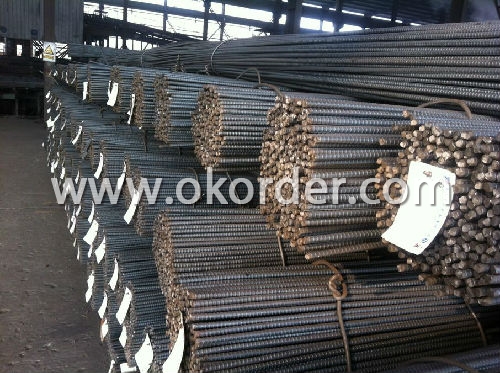
Note:
1. Our products are produced according to national standard (GB), if not, supply according to national standards (GB) or agreement as customer required.
2. Other Grade and Standard Deformed Steel Bar we can supply:
Grade: GR40/GR60, G460B/B500A/B500B/B500C,BST500S
Standard: ASTM, BS, DIN
The Minimum Order Quantity of these products is high, and need to be confirmed.
3. We can not only supply Deformed Steel Bar; if you need anything about building materials, please contact us for further information.
4. Please send us your detail specifications when inquire. We will reply to you as soon as possible. We sincerely hope we can establish a long stable business relationship.
- Q:What are the different types of steel rebars used in bridge piers?
- The different types of steel rebars commonly used in bridge piers include epoxy-coated rebars, stainless steel rebars, and galvanized rebars. These variations are used to enhance the durability, corrosion resistance, and overall strength of the bridge piers.
- Q:What is the impact of steel rebars on the construction timeline?
- Steel rebars have a significant impact on the construction timeline. Rebars are essential components in reinforced concrete structures, providing strength and durability to the overall construction. Their proper installation and integration into the concrete elements are crucial for ensuring the structural integrity of the building. Firstly, the availability and timely delivery of steel rebars affect the construction timeline. If there are delays in the procurement or delivery of rebars, it can cause a ripple effect on the entire project schedule. Construction activities that require the presence of rebars, such as formwork, concrete pouring, and curing, will be postponed or slowed down, resulting in a potential delay in the overall construction timeline. Secondly, the installation of rebars is a meticulous and time-consuming process. Construction teams need to accurately place and secure the rebars according to the design specifications and engineering drawings. This process involves cutting, bending, and tying rebars to create the required reinforced structures. Any errors or rework required during this phase can lead to additional time being spent, potentially causing delays in subsequent construction activities. Moreover, the coordination between different construction trades is crucial when working with rebars. For instance, the electrical and plumbing systems need to be properly integrated with the rebars before the concrete is poured. Any miscommunication or lack of coordination can lead to conflicts and rework, resulting in delays in the construction timeline. Additionally, the quality of rebars plays a vital role in the construction timeline. Poor quality or defective rebars can lead to safety concerns and potential structural issues. In such cases, the construction timeline may be impacted as remedial actions, such as removing and replacing the faulty rebars, need to be taken, causing delays and additional costs. In summary, steel rebars have a significant impact on the construction timeline. Their availability, timely delivery, accurate installation, coordination with other trades, and quality are all factors that can influence the overall progress of a construction project. Proper planning, communication, and monitoring are crucial to ensure that rebars are effectively incorporated into the construction process, minimizing any potential delays and keeping the project on schedule.
- Q:How do steel rebars distribute loads in concrete structures?
- Steel rebars distribute loads in concrete structures by providing reinforcement and increasing the tensile strength of the concrete. The rebars are typically placed in the concrete in a grid-like pattern, creating a network of support throughout the structure. When the concrete is subjected to external loads, such as the weight of the building or the force of an earthquake, the rebars help distribute the load more evenly across the structure. This prevents the concrete from cracking or failing under the stress. Rebars work by transferring the tensile forces to the surrounding concrete. While concrete is strong in compression, it is relatively weak in tension. The rebars act as a reinforcement, resisting the tensile forces and preventing the concrete from cracking. When a load is applied to the structure, the rebars bear a portion of the load and distribute it to adjacent rebars and the surrounding concrete, effectively increasing the overall strength and stability of the structure. The distribution of loads in concrete structures is also influenced by the spacing and diameter of the rebars. Properly spacing the rebars ensures that the load is evenly distributed, minimizing the risk of localized stress concentration. The diameter of the rebars also plays a role in load distribution, as larger diameter rebars can withstand higher loads and provide more reinforcement. In addition to load distribution, steel rebars also help control the propagation of cracks within the concrete. When cracks do occur, the rebars help prevent them from spreading by transferring the stress around the cracked area and maintaining the structural integrity of the concrete. Overall, steel rebars play a critical role in distributing loads in concrete structures by providing reinforcement, increasing tensile strength, and controlling crack propagation. Their strategic placement and proper sizing ensure that the loads are evenly distributed, enhancing the durability and longevity of the structure.
- Q:What are the limitations of using steel rebars?
- Construction projects face several limitations when using steel rebars. To begin with, steel rebars are prone to corrosion. Exposure to moisture and oxygen causes rusting over time, weakening the rebars and compromising the concrete's structural integrity. Protective coatings like epoxy are often applied, but these can degrade and necessitate maintenance. Additionally, steel rebars have a high thermal expansion coefficient, meaning they expand and contract considerably with temperature fluctuations. This can lead to stress and concrete cracking, especially in regions with extreme temperature variations. Engineers often incorporate expansion joints and other methods to accommodate rebars' thermal expansion. Moreover, steel rebars are heavy and can be challenging to handle and transport. Their weight can increase the overall structure's weight, requiring additional support or reinforcement. Additionally, transporting steel rebars to construction sites is costly and time-consuming. Furthermore, steel rebars are a finite resource with environmental consequences. Extracting and producing steel demand significant energy and contribute to greenhouse gas emissions. The depletion of natural resources necessary for steel production is also a concern. Lastly, steel rebars conduct heat and electricity, posing safety risks in certain situations. For instance, in areas prone to lightning strikes, the presence of steel rebars heightens the chances of electrical damage. In conclusion, despite their strength and durability, steel rebars in construction have limitations such as corrosion susceptibility, thermal expansion issues, high weight, environmental impact, and electrical conductivity. Engineers and architects must consider these limitations and implement appropriate measures to address them in construction projects.
- Q:What are the different types of steel rebars used in tunnel construction?
- Tunnel construction incorporates a variety of steel rebars, each possessing distinct properties and advantages. 1. Carbon Steel Rebars: These rebars, widely utilized in tunnel construction, boast exceptional strength and durability, rendering them suitable for rigorous applications. Additionally, they offer a cost-effective solution, making them a favored choice for numerous tunnel projects. 2. Stainless Steel Rebars: Tunnel environments exposed to elevated moisture levels, chemicals, or saltwater benefit from stainless steel rebars, which possess corrosion-resistant qualities. Compared to carbon steel rebars, they have a longer lifespan, ultimately reducing maintenance and replacement expenses. 3. Epoxy-Coated Rebars: Epoxy-coated rebars, comprising carbon steel rebars coated with an epoxy layer, provide additional protection against corrosion. As a result, they are well-suited for tunnels situated in harsh environments or those with high chloride content in the soil or water. 4. Galvanized Rebars: To safeguard against corrosion, carbon steel rebars undergo a zinc coating process, resulting in galvanized rebars. They find common use in tunnels where moisture and water exposure are significant concerns. Galvanized rebars exhibit durability and are relatively cost-effective. 5. Fiber-Reinforced Polymer (FRP) Rebars: FRP rebars, composed of composite materials such as fiberglass and resin, deliver benefits such as lightweight construction, corrosion resistance, and an exceptional strength-to-weight ratio. They prove particularly valuable in tunnels where weight reduction is essential, such as in soft ground conditions or when the tunnel structure has load-bearing capacity limitations. It is crucial to consider various factors, including project requirements, environmental conditions, and budgetary constraints, when selecting steel rebars for tunnel construction. Consulting with structural engineers and experts is imperative to determine the most suitable rebars for a specific tunnel project.
- Q:Can steel rebars be used in fire-resistant structures?
- Yes, steel rebars can be used in fire-resistant structures. The high melting point and strength of steel make it a suitable material for reinforcing concrete in buildings that need to withstand fire. Additionally, steel rebars are often coated with fire-resistant materials to enhance their fire resistance properties.
- Q:What is the recommended method for tying steel rebars together?
- The recommended method for tying steel rebars together is typically using wire ties or mechanical rebar connectors.
- Q:How do steel rebars perform in corrosive environments?
- Steel rebars perform well in corrosive environments, thanks to their inherent resistance to corrosion. The presence of protective oxide layers on the surface of steel rebars helps prevent the penetration of corrosive elements such as moisture and chemicals. Additionally, the use of corrosion-resistant coatings or stainless steel rebars can further enhance their performance in highly corrosive environments.
- Q:What are the different types of corrosion protection coatings for steel rebars?
- There are several types of corrosion protection coatings available for steel rebars, including epoxy coatings, zinc coatings, polyurethane coatings, and fusion bonded epoxy (FBE) coatings. These coatings provide a barrier between the steel surface and corrosive elements, preventing rust and extending the lifespan of the rebars in various environments.
- Q:What are the common quality control tests for steel rebars?
- Steel rebars undergo several quality control tests to ensure they meet industry standards and specifications. These tests assess the rebars' physical, mechanical, and chemical properties to guarantee their durability and performance. Common quality control tests for steel rebars include: 1. Tensile Test: This test determines the rebars' tensile strength, yield strength, and elongation. It involves gradually applying force to the rebar until it breaks, measuring the maximum force it can withstand. 2. Bend Test: This test evaluates the rebars' ability to withstand bending without cracking. The rebar is bent to a specific angle and inspected for visible cracks. 3. Chemical Composition Analysis: This test determines the rebars' chemical composition, ensuring they meet required standards. It involves analyzing the levels of carbon, manganese, phosphorus, sulfur, and other elements. 4. Visual Inspection: This test visually examines the rebars for surface defects like cracks or irregularities that could impact structural integrity. 5. Dimensional Inspection: This test verifies the rebars' dimensions and shape, checking for deviations from specified requirements. Instruments are used to measure diameter, length, and shape. 6. Weldability Test: If the rebars will be welded, a test is performed to assess their suitability for welding. The quality of the weld joint, including strength and brittleness, is evaluated. 7. Corrosion Resistance Test: This test determines the rebars' resistance to corrosion, which is crucial for long-term durability. It involves subjecting the rebars to accelerated corrosion conditions and assessing their resistance. These tests are essential in ensuring the quality and reliability of steel rebars used in construction projects. Manufacturers and inspectors can identify non-compliant or substandard rebars through these tests, ensuring the safety and structural integrity of buildings and infrastructure.
1. Manufacturer Overview |
|
|---|---|
| Location | |
| Year Established | |
| Annual Output Value | |
| Main Markets | |
| Company Certifications | |
2. Manufacturer Certificates |
|
|---|---|
| a) Certification Name | |
| Range | |
| Reference | |
| Validity Period | |
3. Manufacturer Capability |
|
|---|---|
| a)Trade Capacity | |
| Nearest Port | |
| Export Percentage | |
| No.of Employees in Trade Department | |
| Language Spoken: | |
| b)Factory Information | |
| Factory Size: | |
| No. of Production Lines | |
| Contract Manufacturing | |
| Product Price Range | |
Send your message to us
Hot Rolled Deformed Steel Rebars for Constrution
- Loading Port:
- Tianjin
- Payment Terms:
- TT OR LC
- Min Order Qty:
- -
- Supply Capability:
- 200000 m.t./month
OKorder Service Pledge
OKorder Financial Service
Similar products
New products
Hot products
Hot Searches
Related keywords

